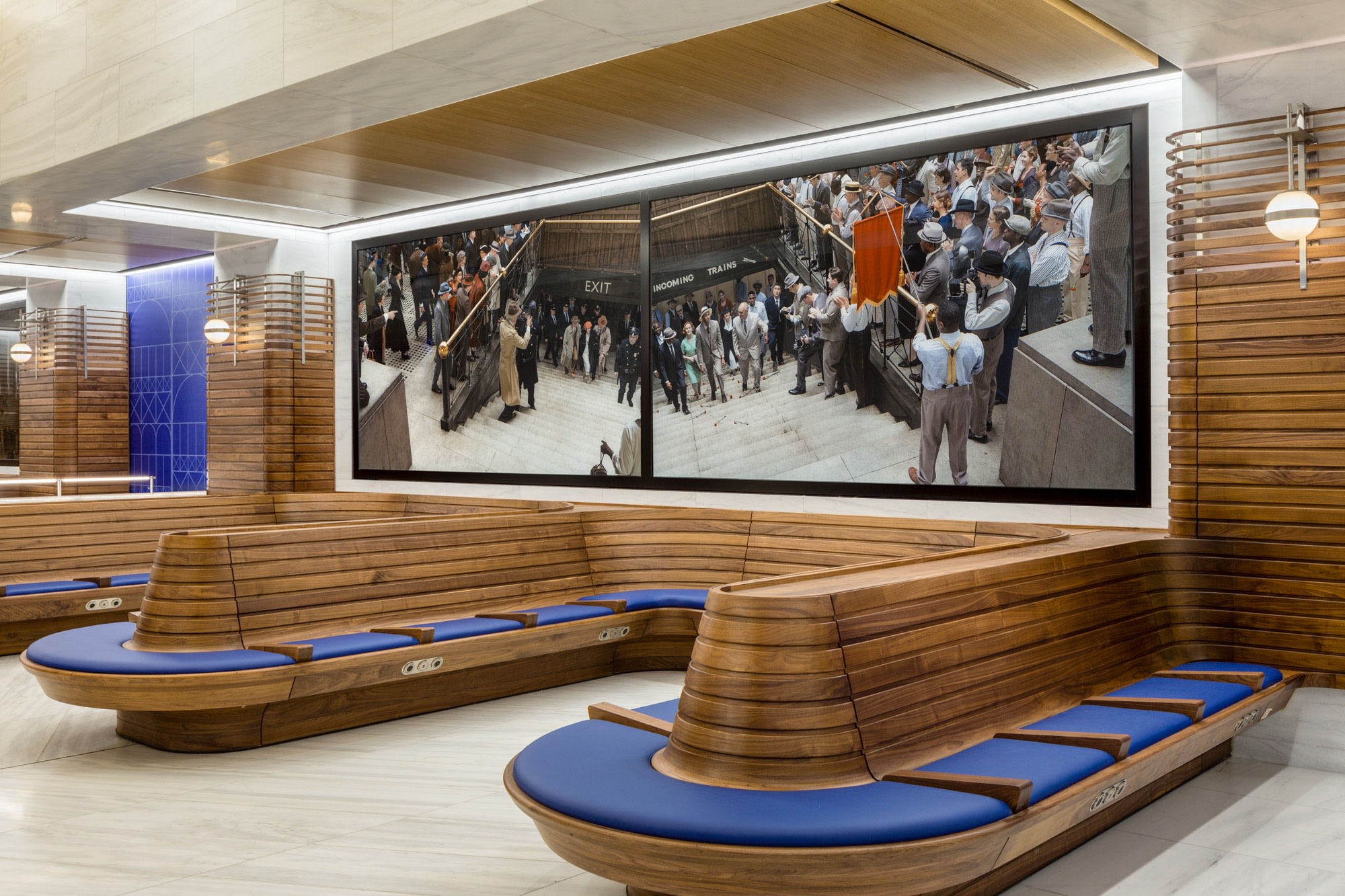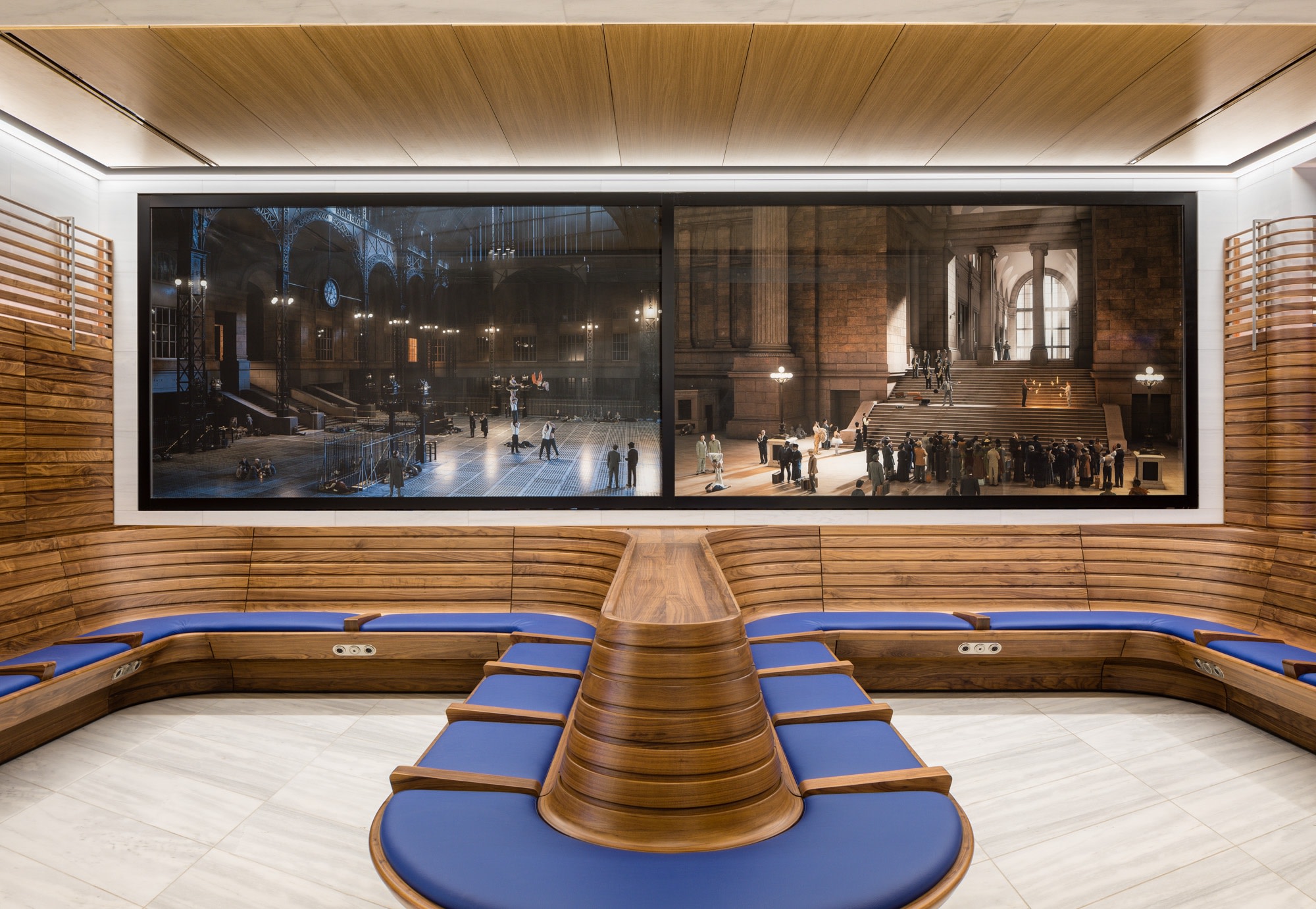Stan Douglas at Penn Station
From 1 January 2021 at Penn Station's new Moynihan Train Hall, three ambitious site-specific permanent installations by artists Stan Douglas, artist duo Elmgreen & Dragset, and Kehinde Wiley go on permanent view. Public Art Fund was invited by Empire State Development to develop and direct a program of ambitious art installations for three prominent sites within the Train Hall. In keeping with the redesigned building’s architectural integration of old and new, the art program commissioned three of the world’s leading artists to create large-scale, site-specific artworks that reflect broadly on notions of past, present, and future.

Stan Douglas has mined the history of the original Penn Station, giving heroic pictorial life to narratives from different moments in time using today’s most advanced digital technologies.
From 1910 to 1963 the original Pennsylvania Station stood one block east of Moynihan Train Hall, on the footprint of today’s Madison Square Garden. The demolition of the grand, Beaux Arts building, designed by eminent American architects McKim, Mead & White, is now considered an incomparable loss to the history of Gilded Age architecture and to the urban landscape of New York. In the Ticketed Waiting Room at Moynihan Train Hall, artist Stan Douglas’s nine photographic panels, arranged in three pairs and one triptych, reconstruct significant but little-known moments spanning the Station’s half-century lifespan, standing as vivid evocations of the city’s forgotten history. In order to recreate both the demolished building and these moments, Douglas undertook extensive archival research. Extrapolating from photographs, newspaper articles, and architectural plans, he restaged historical events by posing and photographing live performers in period costume. Douglas stitched together dozens of exposures to create each tableau, which he then set within exactingly rendered CGI (computer-generated imagery) backgrounds that faithfully reproduce the soaring ceilings and stately concourses of the original Station. Douglas selected events that chronicle the breadth of collective experience for which Penn Station served as a stage. With a cinematic quality, each scene revives history in uncanny detail, revealing this architectural landmark as a grand theater for the millions of human dramas that animate civic spaces and endow them with meaning.

This is complete fantasy – we don’t know what it looked like. We found out who was doing shows on the Eastern Seaboard and incorporated them. We found acrobatic troupes of the era and reference images for costuming and their acts.’ – Stan Douglas
Since the late 1980s, Stan Douglas has used photography, film, and theater to reconsider history and the means of its documentation, which define its shape in our collective memory. Born of exhaustive historical research, Douglas’s artworks bring new focus to overlooked events specific to a particular location. He frequently hones in on intimate, localized moments of spectacle and poignancy that speak to broader societal shifts. In restaging these events, Douglas consciously references the technologies he employs to bring them to life. In Penn Station’s Half Century, depictions of vaudeville performers, Hollywood set designs, and photo mural ad campaigns echo Douglas’s own artistic process, suggesting that photographic documentation has the potential to be a medium of fantasy as much as one of verisimilitude.

Speaking to The New York Times, Douglas said, ‘This is complete fantasy – we don’t know what it looked like. We found out who was doing shows on the Eastern Seaboard and incorporated them. We found acrobatic troupes of the era and reference images for costuming and their acts.’
Conceived specifically for the series of four architectural niches that anchor the rear wall of the Ticketed Waiting Room, the nine individual scenes are connected by multiple narrative threads and introduce subtle details that reveal themselves upon close examination. Penn Station’s Half Century is the artist’s first permanent public commission in the United States.
Read more about the project via Public Art Fund
- Doug Aitken
- Njideka Akunyili Crosby
- Milton Avery
- Jules de Balincourt
- Ali Banisadr
- Hernan Bas
- María Berrío
- Saskia Colwell
- Verne Dawson
- Stan Douglas
- Elmgreen & Dragset
- Inka Essenhigh
- Ian Hamilton Finlay
- David Harrison
- NS Harsha
- Alex Hartley
- Secundino Hernández
- Ilse D’Hollander
- Christian Holstad
- Kudzanai-Violet Hwami
- Chantal Joffe
- Isaac Julien
- Idris Khan
- Yayoi Kusama
- John Kørner
- Doron Langberg
- Wangechi Mutu
- Alice Neel
- Maria Nepomuceno
- Chris Ofili
- Jorge Pardo
- Celia Paul
- Grayson Perry
- Paula Rego
- Tal R
- Conrad Shawcross
- Hedda Sterne
- Do Ho Suh
- Sarah Sze
- Adriana Varejão
- Stephen Willats
- Flora Yukhnovich
- Doug Aitken
- Njideka Akunyili Crosby
- Milton Avery
- Jules de Balincourt
- Ali Banisadr
- Hernan Bas
- María Berrío
- Saskia Colwell
- Verne Dawson
- Stan Douglas
- Elmgreen & Dragset
- Inka Essenhigh
- Ian Hamilton Finlay
- David Harrison
- NS Harsha
- Alex Hartley
- Secundino Hernández
- Ilse D’Hollander
- Christian Holstad
- Kudzanai-Violet Hwami
- Chantal Joffe
- Isaac Julien
- Idris Khan
- Yayoi Kusama
- John Kørner
- Doron Langberg
- Wangechi Mutu
- Alice Neel
- Maria Nepomuceno
- Chris Ofili
- Jorge Pardo
- Celia Paul
- Grayson Perry
- Paula Rego
- Tal R
- Conrad Shawcross
- Hedda Sterne
- Do Ho Suh
- Sarah Sze
- Adriana Varejão
- Stephen Willats
- Flora Yukhnovich
Victoria Miro Venice
San Marco 1994,
Calle Drio La Chiesa
30124 Venice, Italy
t: +39 041 523 3799
info@victoria-miro.com
View map
Opening Times
During exhibitions:
London: Tuesday–Saturday: 10am–6pm.
Venice: Tuesday–Saturday: 10am–1pm & 2–6pm.
We are also closed on Sundays, Mondays and public holidays.
Admission free.
Enquiries
All general enquiries should be sent to
info@victoria-miro.com
Victoria Miro does not accept unsolicited artist applications.
Before contacting or subscribing please read our Privacy Policy
We respect the choices you make about how you would like to hear from us. You will find links at the bottom of all emails we send from our mailing list which allow you to Update your preferences to change the way we contact you, or Unsubscribe if you want to opt out.
Read our Modern Slavery Statement here.
Read our sustainability statement here.
Subscribe
Staff contact details
Directors
Sales
Exhibitions
Communications
Operations
Technical Services
Finance
This website uses cookies
This site uses cookies to help make it more useful to you. Please contact us to find out more about our Cookie Policy.